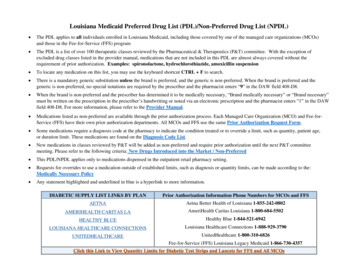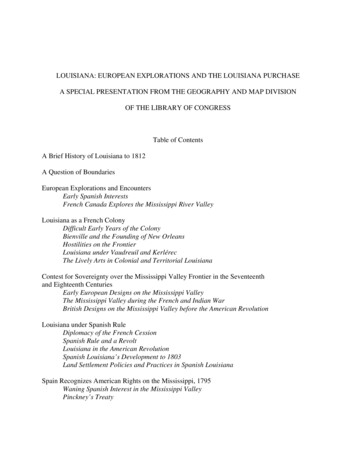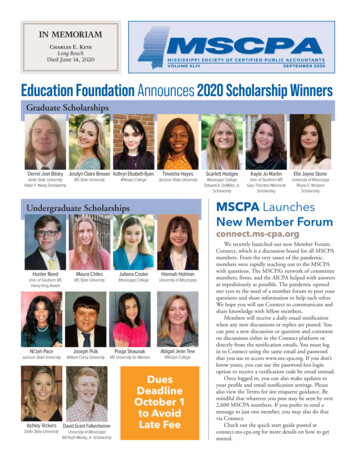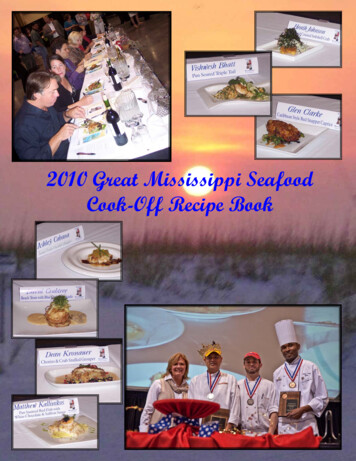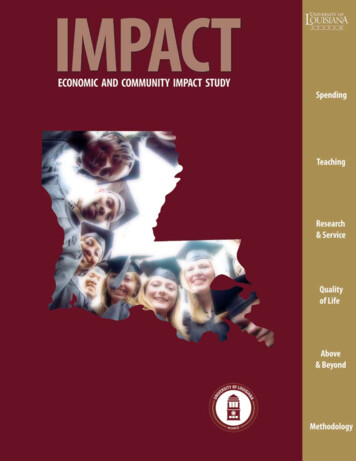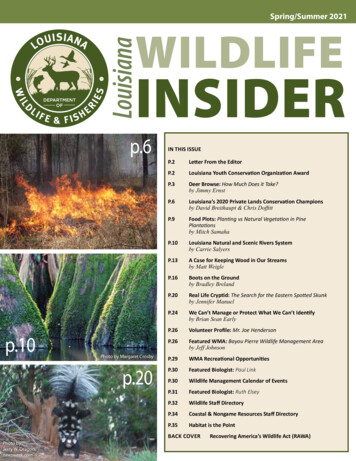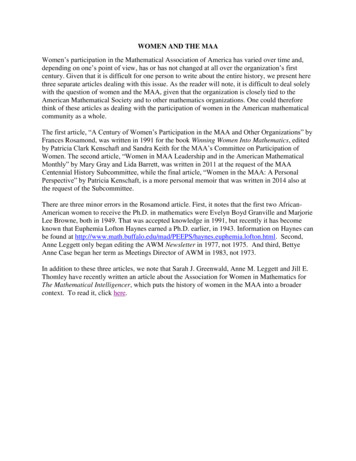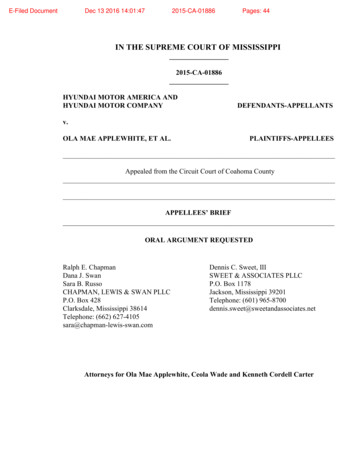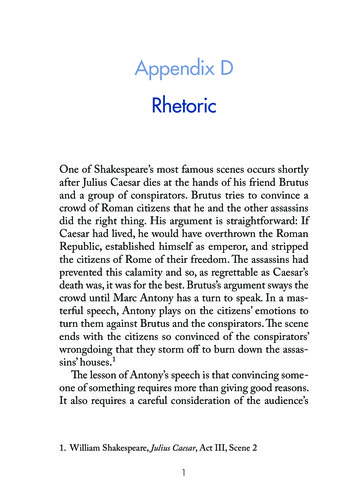
Transcription
The Mathematical Association of AmericaLouisiana/Mississippi Section99th Annual Meeting hosted byNorthwestern State University of LouisianaNatchitoches, LouisianaMarch 03 – 05, 2022
NSU Wi-Fi Guest Access:Wi-Fi Network: nsulaguestUsername: MAAGuestPassword: Demons1884Institutional Partners:Northwestern State UniversityMcNeese State UniversityMississippi CollegeMississippi State UniversityRust CollegeSoutheastern Louisiana UniversityUniversity of Louisiana at LafayetteXavier University of LouisianaInstitutional Partners' Membership Fees help fundstudent activities. Thank you for your support!
Schedule of EventsRegistrationIntegration BeeFood and ESportsRegistrationExhibits & HospitalityCommittee MeetingsStudent Team CompetitionSection NExTStudent AddressAllen Butlerst1 Plenary Session:Anderson LectureJudy WalkerStudent Paper PresentationsFaculty Presentations I2nd Plenary Session:Pólya LectureTalithia WilliamsAnderson BanquetThursday March 3rd5:30 – 8:006:30 – 9:006:00 – 9:001st Floor LobbyHendrick RoomEsports RoomFriday March 4th8:00 – 4:309:00 – 4:309:00 – 4:308:30 – 10:308:30 – 11:3010:45 – 11:452nd Floor LobbyPresidents RoomRoom 221Hendrick RoomCane River RoomHendrick Room1:00 – 2:15Ballroom2:30 – 3:302:30 – 4:154:30 – 5:30Hendrick RoomCane River RoomBallroom6:00Chateau St. DenisSaturday March 5th9:00 – 10:3010:45 – 12:00BallroomBallroomFaculty Presentations II3rd Plenary Session:Outstanding TeacherLeigh Ann MyersBusiness MeetingExecutive Committee12:00 – 1:00Room 221
Invited Speakers:Dr. Butler holds a B.A. in Mathematics from Texas TechUniversity and a PhD in Mathematics from the Universityof Illinois, Champaign-Urbana (1987). He has beenemployed at Daniel H. Wagner Associates, Inc.(www.wagner.com ) since 1987 and is currently a VicePresident and Chair of the Board of Directors. Throughouthis career, Dr. Butler has served as the principal investigator forDepartment of Defense R&D projects involving a variety ofmathematical disciplines as applied to areas such as tracking, trackcorrelation, data fusion, and search optimization. He has been involvedin the development and implementation of optimal search techniques fora number of projects, including a research effort whose goal was theinterdiction of narcotics smugglers in the Caribbean. He recently servedas VP of Practice on the Board of Directors of the Institute forOperations Research and Management Science (INFORMS), currentlyserves on the Board of the Institute for Mathematical and StatisticalInnovation, is a Visiting Lecturer for the Society for Industrial andApplied Mathematics (SIAM), and most importantly is the Treasure ofthe Mathematical Association of America (MAA).Judy Walker joined the faculty at the University ofNebraska –Lincoln in 1996 and has remained there, exceptfor the fall 2011 semester when she was a visiting professorat École Polytechnique Fédérale de Lausanne inSwitzerland. She was named Aaron Douglas Professor ofMathematics in 2012. Professor Walker is an algebraiccoding theorist, with a concentration on connections between codingtheory and algebraic geometry, number theory, and graph theory. She is aco-founder of both the All Girls/All Math program for high school girlsand the Nebraska Conference for Undergraduate Women inMathematics. She served as the MAA’s Pólya Lecturer for 20092011and has given lecture series at the Institute for Advanced Study andat the Sophus Lie Conference Center in Norway. In 2006, she receivedthe MAA’s Haimo Award for Distinguished Teaching, in 2021 she wasnamed an AMS Fellow, in 2019 she was named an AWM Fellow and in2021 she received the outstanding Alumni Achievement Award from theDepartment of Mathematics at the University of Illinois at UrbanaChampaign.
Statistician Talithia Williams is an innovative, awardwinning Harvey Mudd College professor, a co-host of thePBS NOVA series “NOVA Wonders” and a speaker whosepopular TED Talk, “Own Your Body’s Data”, extols thevalue of statistics in quantifying personal healthinformation. She demystifies the mathematical process inamusing and insightful ways to excite students, parents, educators andthe larger community about STEM education and its possibilities. In2015, she won the Mathematical Association of America’s Henry L.Alder Award for Distinguished Teaching by a Beginning College orUniversity Mathematics Faculty Member, which honors faculty memberswhose teaching is effective and extraordinary, and extends its influencebeyond the classroom. It is this excellence that attracted the attention ofonline educational company The Great Courses, which selected Williamsto produce “Learning Statistics: Concepts and Applications in R,” aseries of lectures in which she provides tools to evaluate statistical dataand determine if it’s used appropriately. She is the author of “Power inNumbers: The Rebel Women of Mathematics”, a full-color bookhighlighting the influence of women in the mathematical sciences in thelast two millennia and has narrated several science documentary filmsincluding NOVA’s “Secrets in our DNA” and NOVA’s “Hindenburg:The New Evidence”. Williams is a proud graduate of Spelman College(B.A., mathematics), Howard University (M.S., mathematics) and RiceUniversity (M.A., Ph.D., statistics). Her research focus involvesdeveloping statistical models that emphasize the spatial and temporalstructure of data and applies them to problems in the environment. She’sworked at NASA, the Jet Propulsion Laboratory and the NationalSecurity Agency and has partnered with the World Health Organizationon research regarding cataract surgical rates in African countries. Faithand family round out a busy life that she shares with her husband andthree amazing boys. Through her research and work in the community atlarge, she is helping change the collective mindset regarding STEM ingeneral and math in particular, rebranding the field of mathematics asanything but dry, technical or male-dominated but, instead, a logical,productive career path that is crucial to the future of the country.
Section Next WorkshopFriday March 4, 8:30 – 11:30Cane River Room8:30(Not) All about MAAMichael Pearson, MAA Executive DirectorMichael will share his thoughts on the ways MAA has beencentral to his professional life, and how you can find waysyou can engage with MAA resources and participate in theMAA community to advance your career. For those longtime members, he will also share some of the recent andongoing changes as we look towards a changing landscapein higher education. Bring your ideas and help the MAA setan agenda for the future!9:30Teaching Lessons Learned from the PandemicIn this session members of the Section NExT Committeewill share teaching techniques they have found helpful inthe last two years.Judith Covington, Northwestern State University,Hwamog Kim, Mississippi University for Women,Catherine Putnam, Delta State University,Carmen Wright, Jackson State University,10:30 Ask Us AnythingJudy Walker, University of NebraskaTalithia Williams, Harvey Mudd CollegeThis will be a Q&A session with Anderson Lecturer JudyWalker and Pólya Lecturer Talithia Williams. Potentialtopics might include involvement in professional societies,pros and cons of being in leadership, early career advice,communicating mathematics to the general public, issuesaround diversity, equity, and inclusion in mathematics, oranything else you would like to ask thesemathematicians. Come prepared with your questions!
Student AddressFriday March 4, 10:45 – 11:45Hendrick RoomAllen Butler (UICC, 1987) is Vice-President and Chair of theBoard of Directors of Daniel H. Wagner Associates, Inc., asmall consulting firm focusing on mathematics andscientific software development (www.wagner.com). Aformer member of MAA’s Board of Governors, he currentlyserves as the Treasurer of the MAA and is an activemember of a number of other Professional Organizations (e.g., AMS,SIAM, IMSI, CNU’s PCSE Industrial Advisory Board). Reading,International travel, Texas Holdem, Blackjack, and golf comprise hisprimary interests outside work.Bayes’ Theorem – Making Rational Decisions in theFace of UncertaintyAllen Butler, Daniel H. Wagner AssociatesFriday March 4, 10:45 – 11:45Hendrick RoomA statement of Bayes’ Theorem (aka Bayes’ Rule) can be writtenvery succinctly, but this belies its far-reaching consequences. Inthis talk, I will provide a little of the history behind Bayes’Theorem, a derivation of the mathematical basis in probabilisticterms, and a description of the less formal basis where it is viewedas a form of evidential or inferential reasoning. I will illustrate theutility of Bayes’ Theorem by describing applications from thework of my former company, Daniel H. Wagner Associates, Inc.One of these resulted in the location and recovery of the “Ship ofGold”, the SS Central America, a side-wheel steamer carryingnearly six hundred passengers returning from the California GoldRush, which sank in a hurricane two hundred miles off theCarolina coast in September 1857.
First Plenary SessionAnderson LectureFriday March 4, 1:00 – 2:15Student Union BallroomAnnouncementsWelcomeLeigh Ann MyersProgram ChairMarcus Jones, PresidentNorthwestern State University of LouisianaIntroduction of Anderson LecturerJudith CovingtonSection ChairCoding Theory: A cornucopia of mathematicsJudy Walker, University of Nebraska – LincolnWhenever information is transmitted or stored, errors are bound tooccur. It is the goal of coding theory to find efficient ways ofadding redundancy to the information so that these errors can becorrected. The mathematical study of error-correcting codes beganwith Claude Shannon’s groundbreaking 1948 paper, in which heproved probabilistically that good codes exist. The subsequentchallenge has been to actually find or design these good codes; thisproblem has occupied the minds of many mathematicians,computer scientists and electrical engineers ever since. Inaddressing Shannon’s challenge, many areas of mathematics havebeen drawn upon, including several that are not typically thoughtof as “applied math”. This talk will give a mathematical tourthrough coding theory, focusing especially on the wide range ofareas such as algebraic geometry, number theory, and graph theorythat have played a crucial role in the development of this field.
Presentations OverviewStudent Presentations March 4 2:30 – 3:30, Hendrick Room2:30 Andrew LottSchur's Theorem in Integer Lattices(Millsaps College)2:50 Saima ArifAn Exploration of Higher-Order(Mississippi College)Derivatives3:10 Megan SickingerAnalysis of COVID-19 and(University ofVaccination Administration inSouthern Mississippi) MississippiFaculty Presentations I March 4 2:30 – 4:15, Cane River Room2:30 Alex RiceA precise probability related to(Millsaps)Simpson’s paradox2:50 Edgar Reyesw-Polar Decomposition for O(p,q)(SELU)3:10 Zachary P. BradshawCycle Index Polynomials and(Tulane University)Separability Algorithms in QuantumComputing3:30 Jessica BassPreparing for Praxis Problems(NSU)3:50 Carrie MaggioA Successful Approach to Teaching(NSU)Co-requisite Math CoursesFaculty Presentations II March 5 9:00 – 10:30, Ballroom9:00 Arindam SutradharK1 injectivity of the Paschke Dual(ULL)algebra9:20 Taylor A PoePoncelet Quadrilaterals Four Ways(Mississippi College)9:40 Corwin StanfordAnomaly Detection Using Principal(Jackson StateComponent Analysis forUniversity)Identification of Cyber-PhysicalAttacks in the Hardware-in-theLoop-Based Augmented IndustrialControl System (HAI) Dataset.10:00 Randall Gordon Wills Squares of Repunits and their(SELU)Associated Identities
Student PresentationsFriday March 4, 2:30 – 3:30Hendrick Room2:30Schur's Theorem in Integer LatticesAndrew Lott, lottal@millsaps.eduMillsaps CollegeA standard proof of Schur’s Theorem yields that any r-coloring of{1, 2, . . . , Rr 1} yields a monochromatic solution to x y z,where Rr is the classical r-color Ramsey number, the minimum Nsuch that any r-coloring of a complete graph on N vertices yields amonochromatic triangle. We explore generalizations andmodifications of this result in higher dimensional integer lattices,showing in particular that if k d 1, then any r-coloring of{1, 2, . . . , Rr (Ck)d 1}d yields a monochromatic solution tox1 · · · xk 1 xk with {x1, . . . , xd} linearly independent, whereRr (Ck) is the analogous Ramsey number in which triangles arereplaced by k-cycles. We also obtain computational results andexamples in the case d 2, k 3, and r {2, 3, 4}.2:50An Exploration of Higher-Order DerivativesSaima Arif, snarif@mc.eduMississippi CollegeThis paper presents the concept of Fractional Derivatives, thehistory behind them and how they were developed. In addition tothat, two different approaches to calculating fractionalderivatives are considered: a modification of the integer orderderivative using the Gamma Function as well as the RiemannLiouville Integral. We explore one application of the fractionalderivative in the field of image processing.
3:10Analysis of COVID-19 and Vaccination Administration inMississippiMegan Sickinger, Megan.Sickinger@usm.eduUniversity of Southern MississippiIn this work, we develop a mathematical model to observe thespread of COVID-19 and vaccine administration in Mississippi.How simplistic can a model be to accurately measure the spreadof COVID-19 in short term observations with a vaccine controlmeasure? From this question arose an eight compartmentASIRD-V model, where asymptomatic cases and recoveredpopulation are split between unvaccinated and vaccinated. Weinvestigate the stability and equilibrium points of this model, andsimulations optimize the model's parameters over short periodsof time using both death data and vaccine data given by theCenters for Disease Control. This model observes the impact ofpolicy changes as well as the vaccine rollout in Mississippi tocombat the spread of COVID-19. This work is an extension ofthe summer research on the ASIRD model in the 2020undergraduate Cross Scholar summer research program at theUniversity of Southern Mississippi.https://xkcd.com/1856
Faculty Presentations IFriday March 4, 2:30 – 4:15Cane River Room2:30A precise probability related to Simpson’s paradoxAlex Rice, riceaj@millsaps.eduMillsaps CollegeSuppose two friends are about to participate in a two-day contest inwhich they repeatedly attempt a task with a clear success/failureoutcome (such as shooting free throws on a basketball court). Wehave no specific prior knowledge of the participants’ skills, or ofhow many attempts they will take each day, so we suppose thateach participant’s success rate for day 1, success rate for day 2, andproportion of attempts that take place on day 1 are all chosenuniformly at random between 0 and 1. What is the probability thatthe same person has a higher success rate each of the twoindividual days, but the other person has a higher success rate forthe two-day period? This can be thought of as a prior probability ofa simple case of Simpson’s Paradox, and we show that thisprobability isπ2 936 .0241556778 . . .2:50w-Polar Decomposition for O(p,q)Edgar Reyes, edgar.reyes@selu.edu,Southeastern Louisiana UniversityThe polar decomposition of a nonsingular real matrix is theproduct of a positive-definite real matrix and an orthogonal matrix.In this talk, we generalize the polar decomposition to the indefiniteorthogonal group O(p, q).
3:10Cycle Index Polynomials and Separability Algorithms inQuantum ComputingZachary P. Bradshaw, zbradshaw@tulane.eduTulane UniversityThe cycle index polynomial of a group is an important object inPólya theory. It is interesting that this combinatorial device makesan appearance in the acceptance probability of certain quantumalgorithms that test for the entanglement of a pure bipartitequantum state, an important resource in the field of quantumcomputing. In this talk we discuss this property and answer aconjecture about the behavior of the cycle index polynomial for thesymmetric groups in this context, showing that the algorithmproposed by LaBorde and Wilde becomes more stringent as theorder of the symmetric group increases. This result follows fromthe relationship between the cycle index polynomial and thecomplete Bell polynomials, which satisfy a desirable recurrencerelation. Finally, we conjecture that a similar behavior holds for thecycle index polynomial of any finite group.3:30Preparing for Praxis ProblemsJessica Bass, bassj@nsula.eduNorthwestern State UniversityTo help our mathematics education students prepare for thePraxis exam, I created a course to meet the needs of thesestudents. Students is in this course review material covered bythe Praxis exam and test taking strategies. This talk will discussthe changes regarding the new mathematics content exam andhow we are preparing our students for the exam and theclassroom.
Faculty Presentations IFriday March 4, 2:30 – 4:15Cane River Room3:50A Successful Approach to Teaching Co-requisite MathCoursesCarrie Maggio, maggioca@nsula.eduNorthwestern State UniversityFor the last several years NSU has offered corequisite courses tostudents meeting the criteria. Many different approaches havebeen implemented. Finding the right balance to help studentssucceed in their first math course and beyond has been achallenge. We have developed a course framework that hasallowed students to receive the extra instruction needed tosucceed and gain confidence in their ability to solve problems.https://xkcd.com/2343/
Second Plenary SessionPólya LecturerFriday March 4, 4:30 – 5:30Student Union BallroomIntroduction of Anderson LecturerJudith CovingtonSection ChairPower in Numbers: Unveiling Hidden FiguresTalithia Williams, Harvey Mudd CollegeThe movie “Hidden Figures” brought visibility to the lives ofAfrican American women who served as NASA “humancomputers” in the 1960s, women who dreamed the impossible in afield where their presence was lacking. Meeting the demands of a21st century STEM workforce requires that we look beyondtraditional talent pools to recruit and train individuals typicallyunderrepresented in math. During this talk, I'll discuss mypersonal journey as a woman of color in statistics and share waysin which we can excite public interest in data science, buildingupon the rich legacy of diverse mathematical scientists that havecome before us.https://xkcd.com/1805/
Faculty Presentations IISaturday March 5, 9:00 – 10:30Student Union Ballroom9:00K1 injectivity of the Paschke Dual algebraArindam Sutradhar, arindam1050@gmail.comUniversity of Louisiana at LafayetteLet B be a nonunital separable simple stable C*-algebra withstrict comparison of positive elements and T(B) having finiteextreme boundary, and let A be a simple unital nuclear C*algebra. We prove that the Paschke dualA DB algebra is K1injective. As a consequence, we obtain interesting KKuniqueness theorems which generalize the Brown–Douglas–Fillmore essential codimension property.9:20Poncelet Quadrilaterals Four WaysTaylor A Poe, tpoe@mc.eduMississippi CollegeA consequence of Poncelet's theorem states that given any twopoints in the unit disk, one can find an ellipse with these pointsas foci circumscribed by infinitely many quadrilaterals, each ofwhich is inscribed in the unit circle. We will connect thisbeautiful geometric fact with finite Blaschke products,orthogonal polynomials on the unit circle, numerical ranges ofmatrices, and Mirman's iterations.
9:40Anomaly Detection Using Principal Component Analysis forIdentification of Cyber-Physical Attacks in the Hardware-inthe-Loop-Based Augmented Industrial Control System (HAI)Dataset.Corwin Stanford, j00928757@students.jsums.eduJackson State UniversityPrincipal component analysis (PCA) is a common dimensionreduction technique in which the eigenvectors of a dataset’scovariance matrix that capture the maximum variance within thedata are used to transform said data. The eigenvectors whichcapture the least variance within the data arediscarded. However, these latter components have been shownto be a valuable tool for detecting cyber-physical attacks inindustrial control systems (ICS). When ICS data is transformedusing these components, normal operating data shows littlevariance, but data collected during attacks can vary greatly,resulting in identifiable anomalies. Unlike supervised machinelearning techniques, this does not require information from priorattacks in order to build a detection model. Here, we examine acollection of attacks contained within the HAI dataset, a HIL(hardware-in-the-loop) augmented ICS. A variety of methodsfor selecting PCA components and identifying anomalies areused, and the results compared.10:00Squares of Repunits and their Associated IdentitiesRandall Gordon Wills, rwills@selu.eduSoutheastern Louisiana UniversityDefine a repunit Rn to be an n digit positive integer whose digitsare all 1s. That is Rn 111.111. In this talk we will developvarious identities which express the squares of repunits in terms ofrepunits. This talk is accessible to undergraduates.
Third Plenary SessionBusiness MeetingSaturday March 5, 10:45 – 12:00Student Union BallroomWelcomeFrank SerioNSU Department of MathematicsOutstanding Teacher AddressLeigh Ann MyersOpening of Business MeetingJudith CovingtonRepresentative’s ReportTreasurer’s ReportLaura ShepherdsonChristy Sue LangleyCompetitions Results / Committee ReportsInvitation to 100th Annual MeetingCatherine PutnamClosing RemarksJudith Covingtonhttps://xkcd.com/1403/
Math Word SearchWords can be found going up, down, left, right, and diagonal.A Q R Q X U I G Z W N E Q A V QI F Y A F S L W B I A B L V K RZ S A M E D T J P L Z O E C L TN Y O X N F O Q K X B H R E W HP I X M D E R I V A T I V E S AR I N A O J U I R G P S E H E NV E C T O R S A B V R S U G T HM C S R E T P J F H G U F X E DS Y L I T G A H V A T L E D S UE S W X U E R O I C H U E H E LU Q P E R D A A P C N C U A R DD U A T E B L O L B W L O G I CJ A L R C O L L N R V A I S E NZ R X E S S E Q U E N C E E S KP E T V O T L C K N V A T J U TS R Z E K O N O Z R M G B S Y EI Y O F D R T G P F F L E L M ML I N E A R E G R E S S I O N Tau
Special ThanksMusic provided by Armadillo Jackal Band
Conference Hotels:Chateau St. Denis751 2nd StreetNatchitoches, LA 71457(318) 951-4105Church Street Inn120 Church StreetNatchitoches, LA 71457(318) 238-8888Fairfield Inn & Suites150 Hayes Ave.Natchitoches, LA 71063(318) 354-8007https://xkcd.com/2207/
Friedman Student Union1st FloorCourtyardEsportsVenueSteak ‘nShakeHendrickRoom 121Lobby2nd FloorPresidents Room221Cane River RoomCourtyardBallroomLobbyVic’s
Friedman Student UnionParking: Parking will be in the large parking lot on Sam SibleyDr. across the street from the flagpole and the 2 commuter lotslocated on Caspari St.Banquet: The banquet will beat Chateau St. Denis hotel on2nd Street. Leaving campusfrom Sam Sibley Dr. or CaspariSt., take a right onto UniversityParkway. Take a left onto 2ndStreet, the train tracks passthrough this intersection.Proceed down until 751 2ndStreet. The hotel will be onyour right shortly after Horn St.https://xkcd.com/982/
member of a number of other Professional Organizations (e.g., AMS, SIAM, IMSI, NU's PSE Industrial Advisory oard). Reading, International travel, Texas Holdem, Blackjack, and golf comprise his primary interests outside work. Bayes' Theorem - Making Rational Decisions in the Face of Uncertainty Allen Butler, Daniel H. Wagner Associates
